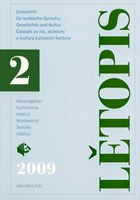Serbsko-němska Łužica – bikulturny rum njezetkawanja? Wuslědki naprašowanja mjez šulerjemi
Sorbian-German Lusatia – a bicultural area of non-meeting? Results from a school survey
Author(s): Cordula RatajczakowaSubject(s): Cultural Essay, Political Essay, Societal Essay
Published by: Domowina-Verlag GmbH / Ludowe nakładnistwo Domowina
Keywords: sorbs; lusatia; bicultural; area; school; survey; bautzen; conflicts; sorbian; language;
Summary/Abstract: This essay analyses selected results from a survey conducted in 2007/8 as part of a research project at the Sorbian Institute. In this survey schoolchildren in Bautzen were interviewed about their attitude towards the Sorbian language. The starting point is the conflict between the official political discourse of the “thousand year old situation of Germans and Sorbs living alongside each other” in the bilingual area and the apparent lack of acceptance of the Sorbian language by German-speaking schoolchildren. This conflict is analysed first of all in three sections. It is shown that the German schoolchildren have hardly any experience of the Sorbian language and that they come into greater contact with other languages, such as Russian or Spanish. Their (rare) contact with Sorbian is described by them in negative accounts, which range from (intentional) exclusion to a feeling of being put down, i.e. receiving the impression that Sorbs spoke in Sorbian in order to insult Germans with impunity. At the same time a high level of acceptance of the Sorbian language in its own right and of bilingualism in the region was registered. This paradox is resolved if a distinction is made between a general acceptance of the language and a rejection of actual language contact. That both phenomena can manifest themselves at the same time can be explained by the background, in which biculturalism is still conceived in Lusatia in the form of two mutually exclusive parallel national worlds, German and Sorbian. The article concludes by arguing in favour of a new intercultural dialogue, which would allow in the future for the possible creation of a common environment in which both languages could exist.
- Issue Year: 2009
- Issue No: 2
- Page Range: 3-15
- Page Count: 13
- Language: Sorbian languages
- Content File-PDF

